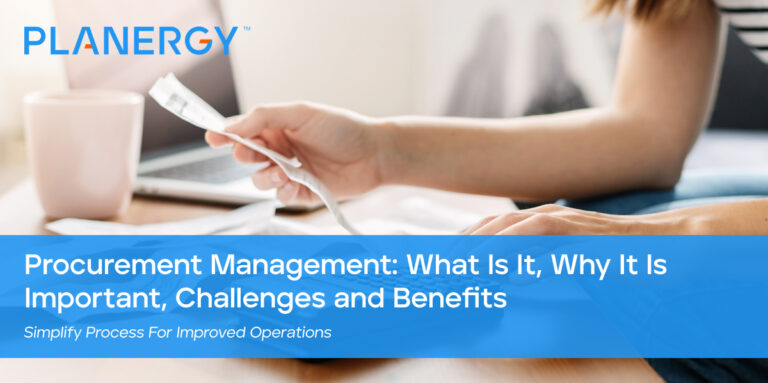Procurement can be a complex and even overwhelming process, especially without the right tools and the right plan. Procurement management aims to get a hold of these processes.
It makes procurement more efficient and gets it working to support your organizational goals.
In this article, we’ll discuss what procurement management is, how you can overcome common procurement challenges, and how you can give your procurement professionals an advantage in a competitive marketplace.
What Is Procurement Management?
Procurement management is the strategy and process behind obtaining the goods and services your organization needs to do business. It involves identifying and evaluating suppliers, then acquiring goods and services from them.
The procurement management process involves sourcing suppliers, negotiating contracts, managing purchase requisitions and purchase orders, and maintaining good supplier relationships.
It also involves tracking supplier performance and availability, much of which ensures that goods and services are of high quality, priced fairly, and delivered on time.
Why Is Procurement Management Important?
Procurement management is important because it can help your organization become more cost-effective, mitigate supply chain risks, and improve your business’s operational efficiency.
Specifically, having a procurement management plan helps you in five key areas.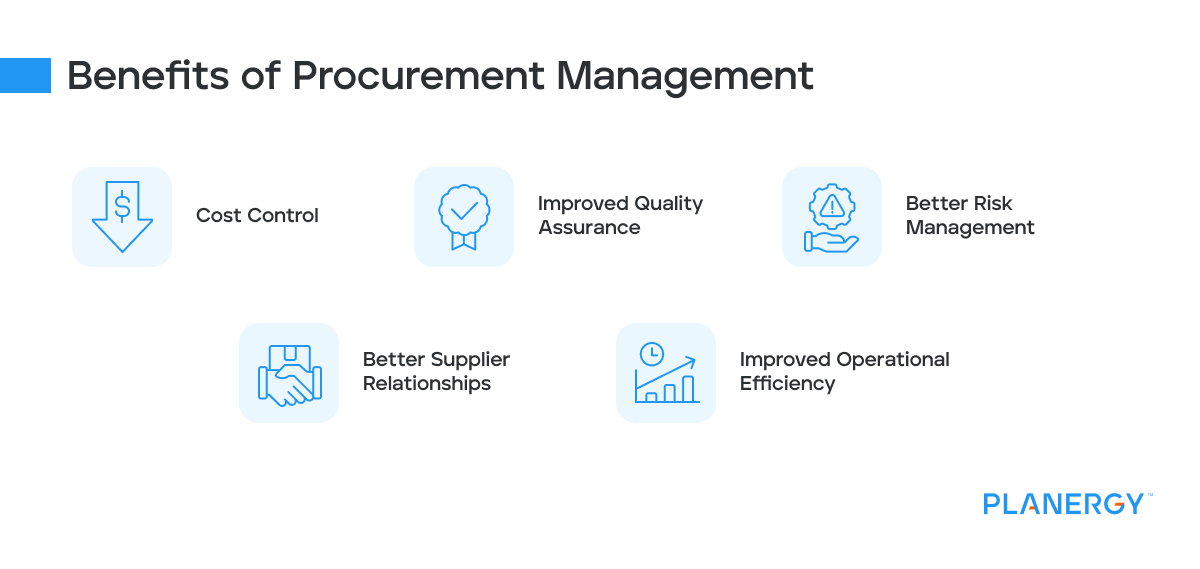
Cost Control
Actively managing the procurement process can help you find the best prices and negotiate more favorable terms with suppliers.
Improved Quality Assurance
Without procurement management, it’s easy to let poor quality standards slip by. Managing this process helps procurement teams can ensure they only purchase high-quality goods and services from reputable suppliers.
Better Risk Management
Procurement management helps identify supply chain risks, such as reliability issues or delivery delays. When these risks are actively identified, teams can work to mitigate them by finding back up suppliers.
Better Supplier Relationships
Procurement management involves actively building and maintaining relationships with key suppliers.
Your company depends on these suppliers, and having a strong, collaborative relationship with them can help both your company and theirs over the long term.
Improved Operational Efficiency
Better procurement management can help ensure procurement processes are optimized to reduce wasted time and remove bottlenecks.
Improved procurement process efficiency can reduce the cost of processing purchases by utilizing business process automation and other technologies.
What Are Procurement Management Challenges?
Procurement management challenges hurt companies that don’t have efficient procurement practices in place.
These companies generally rely on manual, paper-based processes in procurement rather than embracing digital solutions that offer procurement automation.
Manual procurement is riddled with high purchase processing costs, slow approval cycles, and missed discount opportunities.
Vendors and other stakeholders also suffer under inefficient procurement systems. Paper is lost, disputes are harder to settle, and payments often come in late.
Effective procurement management can solve these challenges and help improve supplier relationships.
Procurement management is a strategic approach to optimizing company spend. It ensures you purchase efficiently, from preferred vendors, don’t overspend against budgets, and hit your procurement deadlines.
What Are Procurement Management Best Practices?
Following procurement best practices helps procurement managers achieve the most profitable and efficient procurement process possible.
These procurement management best practices are commonly followed by successful procurement teams.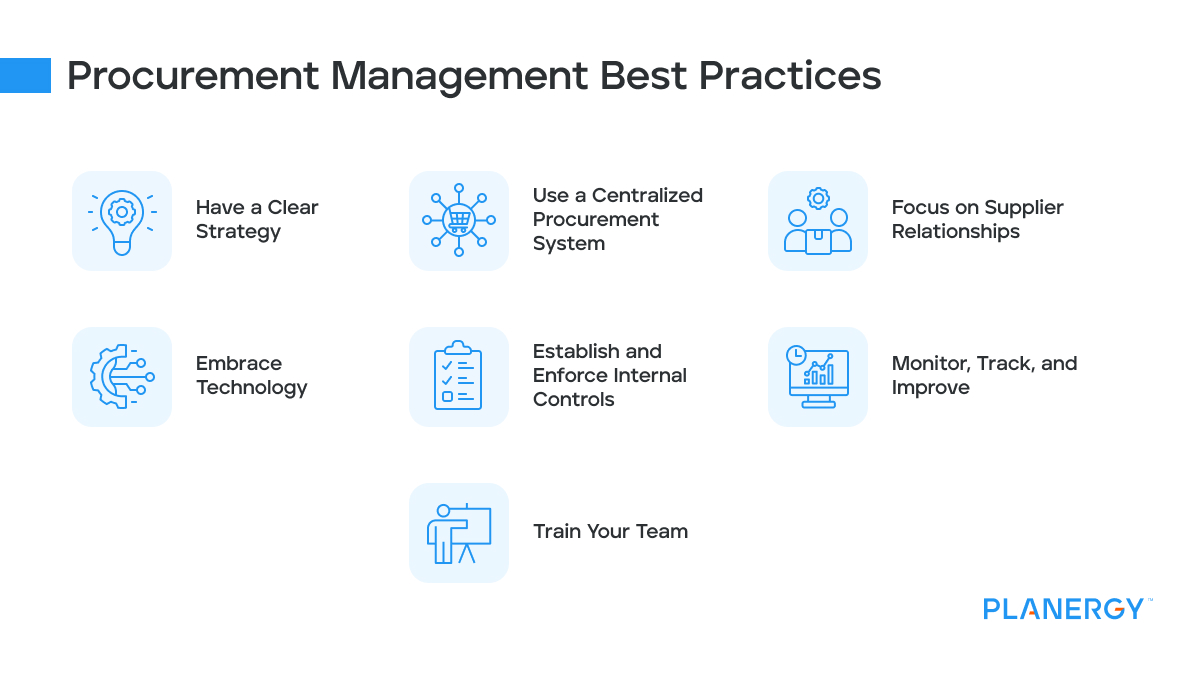
Have a Clear Strategy
Your procurement management plan should be well-defined and aligned with your company’s overall strategy, whether that’s growing the business as fast as possible or cutting costs to the bare minimum.
Identifying and following procurement key performance indicators (KPIs) can help you define and follow your strategic procurement plan.
Use a Centralized Procurement System
Using multiple systems that don’t easily interact with each other is a recipe for disaster.
It can slow down your communication and approval process, and even cause supply chain risks as you aren’t easily able to act in emergencies.
Centralized purchasing can help improve spend visibility and give you automated spend analysis. Using one system streamlines procurement project management.
Focus on Supplier Relationships
It’s easy for procurement teams to treat suppliers as purely transactional entities.
Teams that take the time to build relationships will reap greater benefits, such as better quality, faster delivery, and more flexibility with pricing.Embrace Technology
Due to an unwillingness to change, many procurement teams are stuck in the past using manual procurement processes.
Instead of being tied down to the old system of Excel sheets and paper forms, advanced procurement teams embrace the latest and greatest technology, but they also vet new software to make sure it meets their needs.
Establish and Enforce Internal Controls
Procurement managers need internal policies and controls to ensure budgets are adhered to and compliance requirements are met, but they often have trouble enforcing them.
Requiring your team to use procurement software can help, as you can set the rules and automatically enforce them.
Monitor, Track, and Improve
Don’t just set KPIs, but actually track them in real-time. Procurement management involves continuously improving in several different areas.
Regularly reviewing KPIs and benchmarking procurement is key to steadily improving your procurement function.
Watching those metrics and coming up with ways to improve them is important for success.
Train your team
Anyone involved in the procurement process, either through purchasing or managing, should be well-versed in the tools your company uses.
Ensure that your team has the skills and knowledge they need to not only use your tools but to meet your expectations for performance and following these best practices.
How Can Software Help With Procurement Management?
Procurement management software, also known as procure-to-pay (P2P) software, can help reduce the amount of time and labor it takes to complete the procurement process.
Across your procurement function, procurement software helps cut costs, increase efficiency, and enforce compliance measures. It does this by either automating or streamlining each step of the procurement lifecycle.
For example, when a purchase requisition is submitted for internal approval, the software will automatically route it to the next person in line and notify them to approve it, rather than force the requester to track that person down and remind them manually.
The overall benefits of procurement management software and automation include:
- Reduced Processing Costs
- Reduced Purchase Cycle Time
- Fewer Exceptions
- Improved Compliance
- Enhanced Spend Visibility
- Improved Spend Management
- Increased Productivity in the Purchasing Process
- More Time to Spend on Negotiating Better Purchasing Contracts
- Better overall supply chain management
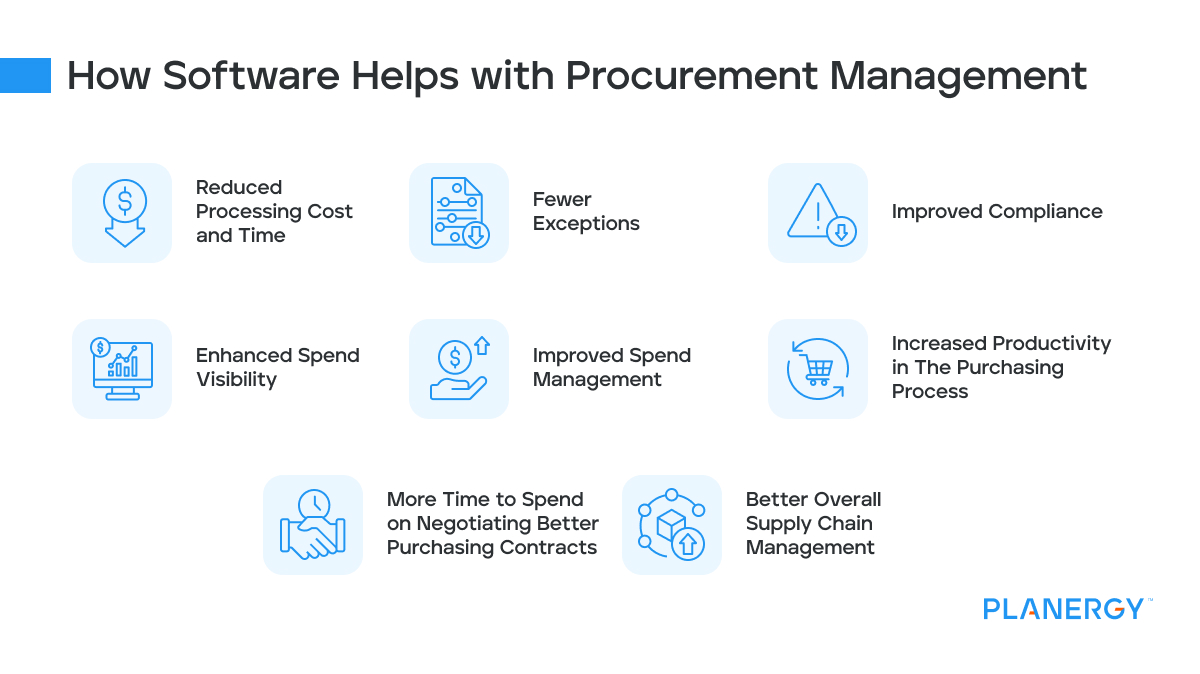
9 Procurement Management Functions That Must be Digitized
According to KPMG, automation can reduce costs by 40-75%. There are many functions within procurement, but these 10 are the most important to digitize and automate.
Using software to remove manual processes from these 10 functions will dramatically cut costs and improve productivity.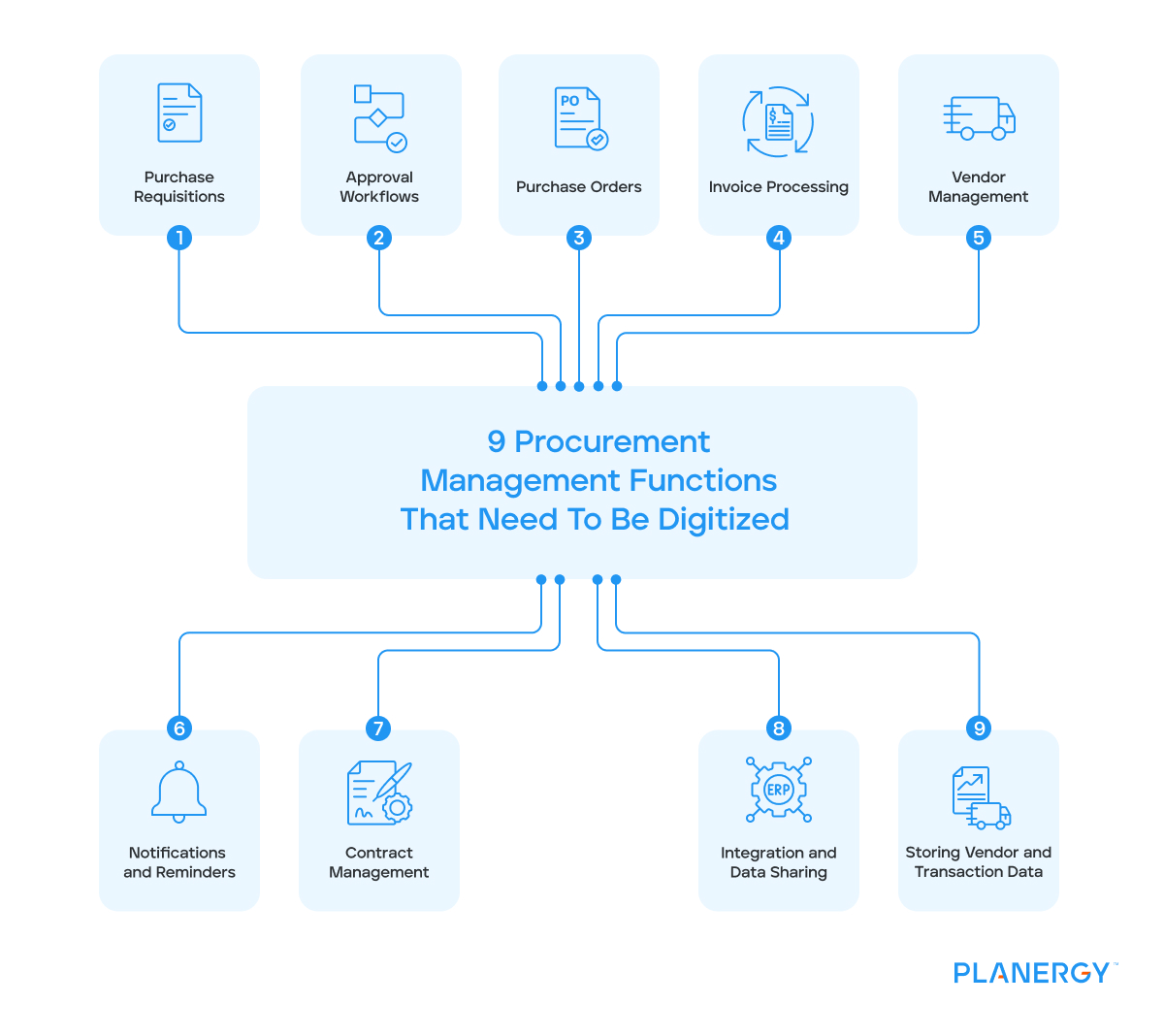
Purchase Requisitions
Purchase requisitions (PRs) are internal requests from team members to their managers and the procurement department to make purchases for goods and services.
They must go through a specific approval process and are turned into purchase orders once approved.
With procurement management software, department heads can allocate budgets and set user permissions so that only the appropriate people can approve requisitions and convert them to purchase orders.
A team member can create a digital PR that states what they need, which vendor they want to use, and when they need it delivered.
Automatic routing will immediately send the PR to the right person for approval, based on value, department, and possibly other factors.
Once approved, it will automatically convert to a purchase order to be delivered to the vendor. If it is not accepted by the supplier, the approver can note why and allow edits to get it approved.
Creating an easy-to-use, digitized requisition flow disincentivizes the use of maverick spend within your organization, as team members are happy to go through the streamlined PR process.
Approval Workflows
With procurement software, purchase orders, requisitions, and invoices that need approval are automatically routed to the right person based on rules that you set and can change when needed.
The rules are flexible and can handle enough to cover various situations based on elements such as organizational structure, out-of-office dates, total value, and more.
You can also set automatic reminders so that when the appropriate reviewers forget or ignore an approval request, they are politely reminded before too much time goes by. With manual processes, people have to manually follow workflows, keep on top of where the order is in that workflow, nudge approvers that are slow to approve.
These are tedious, time-consuming tasks and it can also be awkward for a junior team member to chase senior staff for approval.
Purchase Orders
Using procurement software eliminates the need for Excel, Word doc, or paper-based purchase orders (POs).
It also reduces time spent on data entry, a huge waste of time that also introduces further risk of manual errors.
Approved PRs are automatically turned into POs. They will either become one or multiple POs, depending on the number of vendors used in the PR.
Because software provides data transparency, anyone with permission can quickly locate a PO in the approval chain at any time.
Audit trails ensure accountability because they note the date, time, and people who carried out any action related to the PO. This speeds up PO processing and makes finding documents during the auditing process much easier.
Invoice Processing
Invoice approval and processing become significantly more efficient with procurement automation software linked with AP automation software.
When a vendor submits a paper invoice or emails an invoice, the software solution scans the invoice and extracts the data using optical character recognition (OCR) and artificial intelligence (AI).
The invoice data is then used to perform an automated 3-way matching. This process checks the invoice against the PO and the receipt in order to ensure that the three documents match.
In the event there are discrepancies, the approval system prevents payment and notifies the accounts payable team, procurement team, and/or the vendor of the issue based on pre-defined rules.
Once the issues are fixed, the system automatically forwards the invoice to the accounts payable department for approval and payment.
Vendor Management
Supplier management tasks can be manual, repetitive, and time-consuming.
The vendor selection and evaluation process can be extremely time-consuming. Evaluating performance for existing approvers suppliers or preferred vendors can be difficult.
Procurement management systems can automate many of the tasks such as background checks, request for quote (RFQ) review, follow-ups for missing documents or information, and supplier performance reporting.
Automating these processes improves potential supplier collaboration by speeding up vendor onboarding and improving data accuracy.
When compared to manual processes, procurement management software significantly enhances vendor due diligence, processing, reviewing, and scoring.
Notifications and Reminders
Procure-to-pay software helps eliminate bottlenecks in procurement business operations by sending notifications based on tasks or events. For example, when a requisition needs approval or an invoice needs a final check before payment. Alerts are configured to move tasks along without needing manual follow-up.
Contract Management
Procurement software lends itself well to contract management, which involves storing and managing all procurement contracts across the organization.
In a procurement management system, you can attach contracts and other relevant files to the vendor. This might include documents related to compliance with ESG procurement requirements, relevant certification, or insurance details.
These documents are easily accessible for compliance checks. All you need to do is look up the vendor, and the contract is there.
Integration and Data Sharing
Sharing data between siloed teams and systems, such as an Excel sheet and your accounting system, can be time-consuming and tedious—with endless manual imports and correcting individual cells.
Your procurement management system should enable collaboration between finance, procurement, and other teams.
It should also integrate with other software, such as your accounting platform and enterprise resource planning (ERP) system. These integrations auto-populate data from one system into the other, eliminating the need to manually re-enter data in multiple systems.
Storing Vendor and Transaction Data
Over time, companies that don’t have a consistent data storage plan will end up with a tangled mess. Whether it be huge stacks of paper files or files within files on a local hard drive, procurement software offers an improvement.
Storing vendor information, contracts, purchasing documents, and transaction data under one centralized procurement management system makes it easy to find the information you need quickly.
Automated spend analysis gives insights and identifies savings opportunities in your spend.
Finding relevant data is as simple as clicking on a vendor profile or searching for what you need, and complete data shows up, including a full audit trail of your transaction history.
Procurement Management is an Investment that Pays Off
Switching from manual procurement to digital procurement management saves time, effort, and money across all parts of the procurement process.
It helps procurement managers do a better job, with increased control and better visibility. They’re able to automate tedious tasks, streamline processes, and track every step of the process from end to end.
Procurement management software improves overall efficiency and gives teams the ability to create stronger vendor relationships. It gives organizations a flexible system that works with existing processes while supporting growth.
Investing in your procurement process through software, like PLANERGY, will continuously generate cost savings and improve your bottom line.
You gain greater profitability from your procurement function and your team spends more time creating value for the organization, rather than on tedious tasks.

